
Gyeonggi Province is the most populous province in South Korea.

Kaesong is a special city in the southern part of North Korea, and the capital of Korea during the Taebong kingdom and subsequent Goryeo dynasty. The city is near the Kaesong Industrial Region close to the border with South Korea and contains the remains of the Manwoldae palace. Called Songdo while it was the ancient capital of Goryeo, the city prospered as a trade centre that produced Korean ginseng. Kaesong now functions as North Korea's light industry centre.

Namdaemun, officially known as the Sungnyemun, is one of the Eight Gates in the Fortress Wall of Seoul, South Korea. The gate formed the original southern boundary of the city during the Joseon dynasty, although the city has since significantly outgrown this boundary. It is located in Jung-gu between Seoul Station and Seoul Plaza, with the historic 24-hour Namdaemun Market next to the gate.

Changdeokgung, also known as Changdeokgung Palace or Changdeok Palace, is set within a large park in Jongno District, Seoul, South Korea. It is one of the "Five Grand Palaces" built by the kings of the Joseon dynasty (1392–1897). As it is located east of Gyeongbok Palace, Changdeokgung—along with Changgyeonggung—is also referred to as the "East Palace".
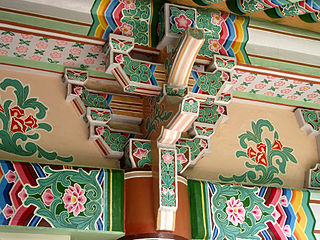
Korean architecture refers to an architectural style that developed over centuries in Korea. Throughout the history of Korea, various kingdoms and royal dynasties have developed a unique style of architecture with influences from Buddhism and Korean Confucianism.

Sejongno (Korean: 세종로), also known as Sejong-daero, is a street that runs through Jongno-gu in downtown Seoul. It is named after King Sejong the Great of Joseon. The street is 600 meters in length, but due to its central location it is of great symbolic importance. It points north to Gwanaksan and Bukhansan (Mountains), and the Joseon Dynasty palace, Gyeongbokgung. It is also of historical significance as the location for royal administrative buildings and features statues of the Admiral Yi Sun-sin of Joseon Dynasty and King Sejong the Great of Joseon.

The history of Seoul can be traced back as far as 18 BC, although humans have occupied the area now known as Seoul since the Paleolithic Age. It has been the capital of numerous kingdoms on the Korean Peninsula since it was established.

This is a timeline of Korean history.

Yeouido is a large island on the Han River in Seoul, South Korea. It is Seoul's main finance and investment banking district. It is 8.4 square kilometres (3.2 sq mi) large and has a population of 32,674 as of August 2023.
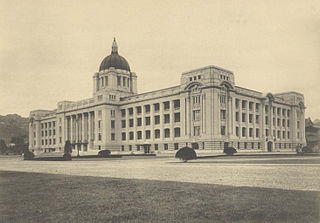
The Japanese General Government Building, also known as the Government-General Building and the Seoul Capitol, was a building located in Jongno District of Seoul, South Korea, from 1926 to 1996.

Namdaemun Market (Korean: 남대문시장) is a large traditional market in Seoul, South Korea. It is located next to Namdaemun, the main southern gate to the old city. The market is among the oldest extant markets in Korea, having opened during the Joseon period in 1414.

Jung District is one of the 25 districts of Seoul, South Korea.
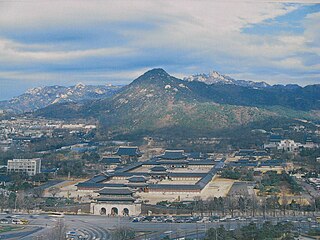
Jongno District is a district in central Seoul, South Korea. It is the historic center of Seoul, and contains the Joseon-era royal palace Gyeongbokgung and the former presidential residence, the Blue House.
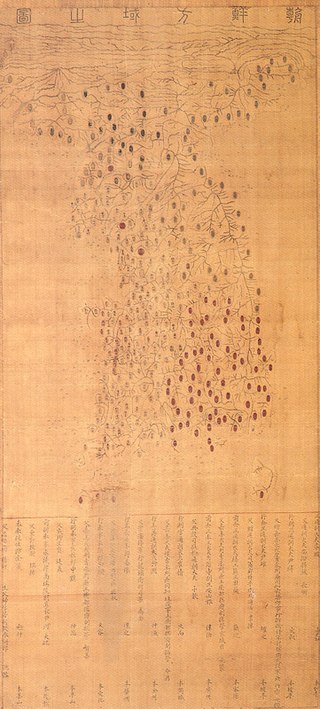
Korea has had a number of capitals. Korea is a peninsula in East Asia, currently the peninsula is divided into two countries: North Korea's capital is Pyongyang, and South Korea's capital is Seoul.

Seoul, the capital of South Korea, has been called by a number of formal and informal names over time.

Seoul, officially Seoul Special City, serves as the capital of South Korea, and is its most extensive urban center. The broader Seoul Capital Area, encompassing Gyeonggi province and Incheon metropolitan city, emerged as the world's fourth largest metropolitan economy in 2014, trailing only Tokyo, New York City, and Los Angeles, hosting more than half of South Korea's population. Although Seoul's population peaked at slightly over 10 million, it has gradually decreased since 2014, standing at approximately 9.97 million residents as of 2020. Seoul is the seat of the South Korean government.
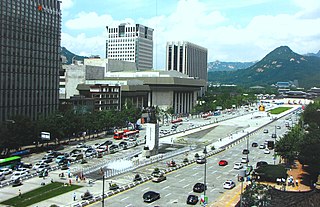
Gwanghwamun Square is a public square on Sejongno, Jongno-gu, Seoul, South Korea. Serving as a public space and at times road for centuries of Korean history, it is also historically significant as the location of royal administrative buildings, known as Yukjo-geori or Street of Six Ministries; and features statues of Admiral Yi Sun-sin of Joseon Dynasty and King Sejong the Great of Joseon.

Outer old Seoul or Seongjeosimni was the area of Seoul located outside of the Fortress Wall but within the city limits during the Joseon period. Outer old Seoul corresponds to the island of Yeouido and present-day Seoul city districts of Eunpyeong, Mapo, Seodaemun, Yongsan, Dongdaemun, Seongbuk, Gangbuk, and Seongdong.

There are a number of palaces in various places in Korea that have been built over the course of several thousand years and several historical monarchies. Many have survived into the present. Some have been destroyed and have since never been rebuilt. And some, such as Gyeongbokgung, have been rebuilt after being destroyed.
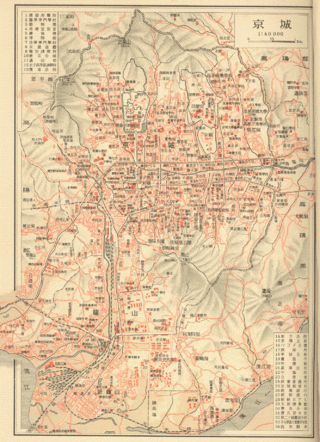
Keijō (京城), or Gyeongseong (Korean: 경성), was an administrative district of Korea under Japanese rule that corresponds to the present Seoul, the capital of South Korea.




















